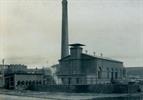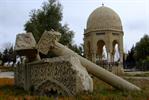He was called the “Father of the Nation” in the late nineteenth and early twentieth centuries. An illiterate man from a poor family, he was mentioned in the media and books of his time more frequently than any state official or member of the intelligentsia.
Haji Zeynalabdin Tagiyev was born to the family of a Baku cobbler in 1838. He lost his mother at an early age. His father sent him to learn stonemasonry. By age 15, he had already mastered the skills needed to be a good stonemason.
Having saved some money, Tagiyev invested in the most profitable business of the 1870-1890: the oil industry. Together with two partners, he started drilling for oil in Bibi Heybat in 1873. Over the next five years, all of their efforts proved fruitless. There was no oil. But Tagiyev, a man known for his perseverance, continued drilling. On a brilliant day, oil started gushing out.
This single event, and also the way Tagiyev eventually built his businesses led the great Russian chemist Dmitriy Ivanovich Mendeleyev to write that Tagiyev was “quite an important” person in Baku’s oil industry. He said that Tagiyev was a good example of how one could quickly amass fortune “without any resources but with a clever approach to all operations”.
Tagiyev’s oil business was a complex one. It included oil drilling, refining, storing, transportation and sale. In some years, Tagiyev’s company extracted more oil than Baku’s leading producer of oil, the Nobel Brothers, did.
Correctly predicting a looming crisis in the oil industry, Tagiyev sold his oil company (estimated at 20 million rubles, according to some data) to the British company Oleum in 1897. But he also became a member of the board of directors of that company. That decision was important in terms of revealing the phenomenon of Tagiyev, an absolutely illiterate man who did not know the theory of economy but could predict the crisis. The ability to accurately evaluate the situation and make the right decisions is extremely important for business people. Thanks to this, Tagiyev managed to overcome the serious crisis in the oil industry.
It was Tagiyev who initiated something that is being paid big attention in today’s Azerbaijan – that is using oil money for the development of the non-oil sector of the economy. He invested the money from the sale of his oil company in the constriction of a textile factory in Baku. Tagiyev had interest in almost every sphere of the Azerbaijani economy. He invested in shipping, ship building, the energy sector, cotton cultivation, fishing, real estate, banking, etc. He founded the Baku Trade Bank. The mill he built in the village of Ahmadli, near Baku, was one of the largest of the time. It operated three diesel engines, while the other mills had none.
Haji Zeynalabdin Tagiyev was an entrepreneur who cared not only about his incomes but also about the living conditions of the people working for him. For instance, unlike the textile factories run by the Nobel Brothers, Tagiyev’s textile factory had been designed as a production-residential compound by renowned architect Goslavskiy. It was the first compound especially built for workers in Baku.
Tagiyev was not only a successful businessman but also a leading public figure. As a member of the Baku Duma for many years, he participated in the planning and implementation of many infrastructure projects in the city. The best known projects financed by Tagiyev include a horse-rail road in Baku and the Shollar water pipeline. In 1885, he proposed a comprehensive program for the construction of public buildings, schools, mosques, churches, gardens, etc. in Baku. Tagiyev had presented a project to the Baku uprava (municipality) on the construction of a theatre on a patch of land owned by him. Built in 1883, it was the only theatre in Baku for many years. Actors from the Maliy (Small) and Mariinskiy theatres (Moscow) played on the stage of this theatre.
A luxury palace built by Tagiyev in central Baku added new elements to the architecture of the city. The palace is now being used as the National Museum of Azerbaijani History.
As has been said, Tagiyev was an illiterate person. But he paid very big attention to the education of his people. He said: “In view of my people’s need for education, I did not stay away [and helped] as much as I could. Having realized the need for opening of schools for the education and upbringing of small children, and the publication of books and newspapers for the education and development of adults, I helped with this and will continue to do so in the future… I really understood that the happy future, tranquility and development of the people lie with education.”
It was because of his care for education that Tagiyev funded the constriction of many schools and provided them with financial support. They included a secondary technical school, a female Russian-Muslim school and a commerce school in Baku and also a Muslim school in Tiflis (now Tbilisi). The great philanthropist also helped schools in Derbent, Vladikavkaz, Chernigov and other towns of Russia.
The school built for Muslim women in 1901 was the climax of Tagiyev’s support for education in Azerbaijan. He allocated 150,000 rubles for the construction of that school, which he named after Empress Alexandra Fedorovna. When the Russian interior minister reported this to Czar Nicolas the Second, the czar told the minister to convey his gratitude to Tagiyev. He also received many awards from the czar and the empress for his support for education.
Tagiyev was a true lover of his people. He provided scholarships to dozens of young people studying at various universities of Russia. Some of the students later became prominent politicians and scientists. In 1898, Tagiyev donated 50,000 rubles, and later an additional 1,000 rubles to the St Petersburg Muslim Charity. He was elected an honorary member of the charity.
Tagiyev also participated in fundraising for the construction of a mosque in St Petersburg – which was the largest in Europe.
After the invasion of Azerbaijan by the Bolshevik Russia in 1920, all of Tagiyev’s wealth was confiscated by the state. He lost everything that had accumulated through many years of hard work. But he managed to escape death in the hands of Bolsheviks during the years of the “Red Terror”. That was thanks to Nariman Narimanov, head of the government of the Soviet Azerbaijan whose university education had been paid for by Tagiyev.
In 1922, two years after the establishment of the Soviet rule in Azerbaijan, Tagiyev’s theatre was reopened after restoration. Despite the different ideology of the Bolsheviks, he was invited to the reopening ceremony. Three actors from the theatre went to Tagiyev’s dacha in Mardakan for him. (It was the only dacha the Soviet government had allowed Tagiyev to keep.) When Tagiyev entered the building, everybody, including the Soviet commissars, stood up to greet him.
Tagiyev thanked for the invitation and for the restoration of the theatre.
The devout Muslim later compared his impression of this event with the feeling he had only once in his lifetime – when he touched the black stone in the holy city of Mecca.
Haji Zeynalabdin Tagiyev’s heart stopped beating on 1 September 1924. His children and relatives had to overcome many difficulties during the Soviet period simply because this great man had been classified as an “alien element” under the Communist rule. But it was impossible to erase him from memories. Despite all the efforts to blacken him, people continued to remember Haji for his deeds and services to his people. As President Ilham Aliyev has said, “this personality, who had amassed big wealth thanks to his hard work, made a great contribution to the enlightenment of the Azerbaijani youth”.
If you're planning a trip to Azerbaijan you may be interested ▶ Azerbaijan highlights - For those who prefer to go unbeaten path, to explore less visited places and check national charisma of this small country in Southern Caucasus on the edge of Europe.










